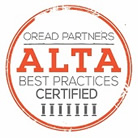November Office Closures
Our offices will be closed Monday, November 11, 2024 in observance of Veterans Day and Thursday, November 28, 2024 in observance of Thanksgiving Day.
Our offices will be closed Monday, November 11, 2024 in observance of Veterans Day and Thursday, November 28, 2024 in observance of Thanksgiving Day.
Ins and Outs of Title and Settlement in Texas
Thursday, November 14, 2024
10:00 am PST
Click here to register.
Successfully closing reverse mortgage transactions can be an intricate and complex process. With ARS, you’ll have the advantage of an experienced team that understands the settlement requirements and intricacies of HECM and proprietary closings. Put our specialized knowledge to work for you to get your transactions closed the right way – with minimum hassle and no unpleasant surprises down the road.
As a full-service title and settlement company dedicated to reverse mortgage closings nationwide, our experienced team provides security and peace of mind for lenders, mortgage brokers and senior borrowers that their transactions will be completed accurately and on-time with a process that’s efficient and easy.

Disadvantages of working with non-reverse title company:
Reverse specific amounts and terminology:
Recording documents before disbursing is not required for reverse transactions and can cause funding delays.
We have excellent relationships with all parties involved in the closing of a reverse mortgage.
Reverse mortgages have significant differences in the types of documents:
Notaries without reverse mortgage experience can cause delays or a negative experience:
We are constantly updating to reflect any increases or decreases in state fees or underwriter changes to ensure you are pulling accurate quotes each time. Our calculator has been updated to reflect fee changes in the following state(s):
Alaska
Conveniently get a quote any time, day or night, by simply and accurately inputting the required information and let our interactive fee calculator do the rest. Please call 844-808-8299 or email Solutions@AllegiantReverse.com for further details or for a quote.
Thursday, October 17, 2024
10:00 am PST
Click here to register.
What sets StewartNow apart from other property profile tools? Not only will StewartNow provide you with a property profile (including property details, transaction history and sales comparables), but it will also provide you with access to search and download copies of recorded documents (county permitting).
Want to give StewartNow a try? Email Solutions@AllegiantReverse.com to request an account.

Where do we go at the end of the day? Some go home to spend time with loved ones, some have passion projects, and some participate in community work. For Adan Gutierrez, our Assistant Vice President, he does all three with Kalpulli Xihuacoatl, an Aztec Dance Group established in 1996. From the Nahuatl language of the Aztecs, Kalpulli means community, Xihua means woman and Coatl means serpent. Their mission is to preserve their culture for future generations by sharing Mexican traditions with the community. Their Founder, Irene Adame, lead with the joy of teaching others and honoring those who came before them.
In 2017, Irene passed away from cancer and Adan continues her legacy today as Kalpulli Xihuacoatl’s Captain. Adan joined the group in 2012. He was born in Mexico and was drawn to “the discipline and the respect for tradition and culture.” Now, all five of his children, nieces and nephews are also members of the dance group. Adan says he’s “learned that to reach immortality you must teach” and what he loves most is “when children look at you in awe and ask lots of questions.”
Pictured Above: Adan Gutierrez.

For almost 20 years, Kalpulli Xihuacoatl has hosted a Dia De Los Muertos celebration for the Sacramento community. Dia De Los Muertos is a special ceremony for our deceased loved ones. On this day, the spirits come to enjoy the essence of the food they liked the most, the aroma of the cempohuxochitl or cempasuchil “flowers of the dead”, and the aroma of the copal (tree sap). Calacas (skeletons) and calaveras (skulls) are prominent symbols of the holiday. In Mexico, people make offerings to their deceased loved ones at cemeteries on November 1 and 2. They also set up altars in their homes, called ofrendas, to welcome the souls of the dead back. Traditional foods include pan de muerto, a sweet baked good, as well as spicy dark chocolate and atole, a corn-based drink. These altars are decorated with bright yellow marigold flowers, photos of the departed, and the favorite foods and drinks of the one being honored. The offerings are believed to encourage visits from the land of the dead as the departed souls hear their prayers, smell their foods, and join in the celebrations! Learn more about Kalpulli Xihuacoatl and their Dia De Los Muertos celebration by visiting their Facebook page. https://www.facebook.com/kalpullixihuacoatl/
Pictured Right: An ofrenda from the Dia De Los Muertos celebration.

Pictured Above: Kalpulli Xihuacoatl with Dolores Huerta, an American labor leader and civil rights activist who, with Cesar Chavez, is a co-founder of the United Farmworkers Association.
Written By: Mylene Marcelo, Title Manager/Title Officer
When a couple gets married, the assets owned by the married couple will depend on the different rules of the different states where they live in. There are some states which recognize the concept of tenancy by the entirety and there are some that do not. Tenancy by the entirety or TBE is a type of ownership only available to married spouses.
When Harry met Sally and decided to get married in New York, they will have to meet certain conditions for TBE in order to apply to their property. They will have to be married when they acquired the property. They will also need to own and possess the property and will need to have interest equally. Both of their names should be listed on the same deed and must hold title to the property at the same time. These conditions comprise the unities of time, title, interest, possession and marriage and they all must be met before an asset can fall under the dominion of TBE.
How does TBE end? It can be by gifting the property to another party, by divorce or by death. In some states like Virginia and Florida, TBE offers debt protection when a spouse dies as long as they were married and never divorced. ARS will normally require an executed Continuous Marriage Affidavit from the surviving spouse and proof of death. The legal document that ARS will accept as proof of death will be an original or certified copy of the death certificate. Not all states will offer TBE protection such as New York, New Jersey and Pennsylvania to name a few.
TBE is a large concept that needs to be discussed further, and it is subject to the state’s recognition and specific laws. Since it varies from state to state and every situation is different, it is best to contact our Underwriting staff equipped with the knowledge and experience in dealing with any TBE issues that may arise in your transaction.
Our offices will be closed Monday, September 2, 2024 in observance of Labor Day.

Our calculator has been updated to remove the title insurance premium field and now includes the Uninsured Property Report (UPR) for the HomeSafe 2nd in all states excluding TX, UT and SC. In the affected states, we will now be issuing the UPR and will no longer be providing a CPL, title commitment, or policy. Please […]
We are constantly updating to reflect any increases or decreases in state fees or underwriter changes to ensure you are pulling accurate quotes each time. Our calculator has been updated to reflect fee changes in the following state(s): -Mississippi Conveniently get a quote any time, day or night, by simply and accurately inputting […]
Proud members of

Trusted and Verified by


